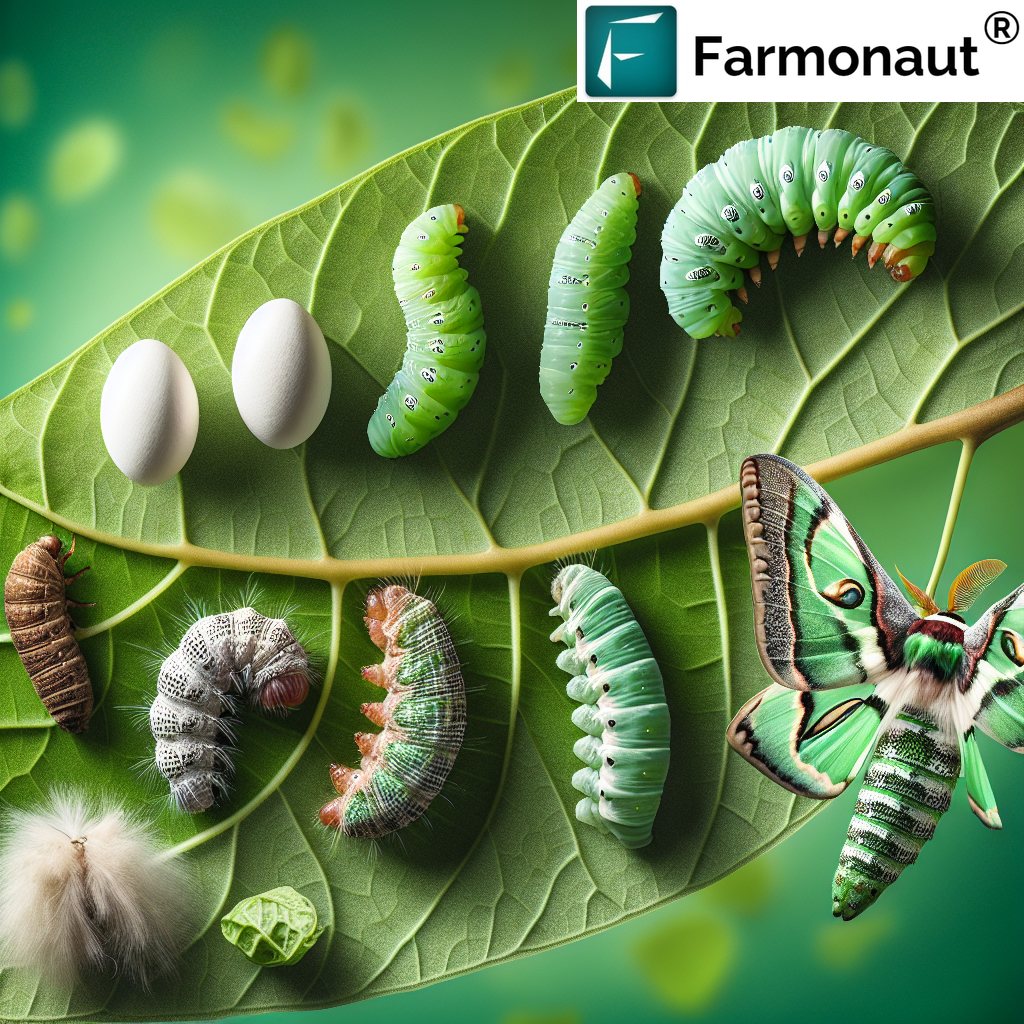Castor Semilooper: Identifying and Managing this Devastating Pest in Your Crop

In the world of agriculture, pests are a constant challenge that farmers face. Among these, the castor semilooper stands out as a particularly troublesome pest for castor bean cultivators. As experts in agricultural technology and pest management, we at Farmonaut understand the critical importance of identifying and managing this devastating pest effectively. In this comprehensive guide, we’ll delve deep into the world of castor semiloopers, exploring their lifecycle, damage patterns, and most importantly, how to protect your valuable castor crop.
Understanding the Castor Semilooper
The castor semilooper, scientifically known as Achaea janata, is a notorious castor pest that can wreak havoc on castor plantations. This lepidopteran insect belongs to the family Noctuidae and is known for its distinctive “looping” movement, which gives it its common name “semilooper.”
Lifecycle of the Castor Semilooper
To effectively combat this pest, it’s crucial to understand its lifecycle:
- Egg Stage: Female moths lay spherical, pale green eggs on the underside of castor leaves.
- Larval Stage: The castor semilooper larva hatches from the egg and goes through several instars.
- Pupal Stage: The mature larva enters the castor semilooper pupa stage, usually in soil or leaf debris.
- Adult Stage: Moths emerge from the pupae, ready to mate and lay eggs, continuing the cycle.
Identifying Castor Semilooper Damage
Recognizing castor semilooper damage early is key to preventing severe crop losses. Here are some telltale signs:
- Irregular holes in leaves, often starting from the leaf margins
- Skeletonized leaves with only veins remaining
- Defoliation of entire plants in severe infestations
- Presence of larval frass (excrement) on leaves and ground
Castor Semilooper Damage Symptoms
The castor semilooper damage symptoms can vary depending on the severity of the infestation:
- Early Stages: Small, irregular holes in leaves
- Mid Infestation: Larger areas of leaf damage, reduced photosynthetic capacity
- Severe Infestation: Complete defoliation, stunted growth, and potential plant death

The Impact of Semilooper in Castor Cultivation
The presence of semilooper in castor fields can have devastating consequences for farmers. These pests can cause significant economic losses due to:
- Reduced crop yield
- Decreased oil content in castor beans
- Increased production costs due to pest management
- Potential total crop failure in severe cases
Integrated Pest Management for Castor Semilooper
At Farmonaut, we advocate for an integrated approach to pest management. Here’s a comprehensive strategy to control castor semiloopers:
1. Monitoring and Early Detection
Regular field monitoring is crucial. Our satellite-based crop health monitoring system can help detect early signs of pest infestation. Learn more about our app.
2. Cultural Control Methods
- Crop rotation with non-host plants
- Proper field sanitation to remove plant debris
- Adjusting planting dates to avoid peak pest seasons
3. Biological Control
Encouraging natural predators and using biopesticides can be effective:
- Release of parasitic wasps (Trichogramma spp.)
- Application of Bacillus thuringiensis (Bt) formulations
- Use of neem-based products
4. Chemical Control
When necessary, judicious use of approved insecticides can help control severe infestations. Always follow local regulations and guidelines for pesticide use.
5. Technological Solutions
Leveraging advanced technology like Farmonaut’s satellite-based monitoring can provide early warnings and help in targeted pest management. Our Jeevn AI Advisory System offers personalized recommendations for pest control.
The Role of Satellite Technology in Pest Management
At Farmonaut, we’re pioneering the use of satellite technology in agriculture. Here’s how our system compares to traditional monitoring methods:
| Feature | Farmonaut Satellite System | Drone-based Monitoring | IoT-based Monitoring |
|---|---|---|---|
| Coverage Area | Large-scale (Entire farms) | Limited by flight time | Limited by sensor placement |
| Frequency of Data | Regular updates (Every 3-5 days) | On-demand, weather dependent | Continuous, but localized |
| Cost-effectiveness | High | Medium | Low (High initial investment) |
| Ease of Use | User-friendly app interface | Requires skilled operator | Requires technical setup |
| Data Analysis | AI-powered insights | Manual interpretation often needed | Depends on system capabilities |
To learn more about our satellite-based solutions, visit our API documentation.
Case Studies: Successful Management of Castor Semilooper
While we don’t have specific case studies to share, our experience working with farmers across various regions has shown that integrated pest management, combined with technological solutions like satellite monitoring, can significantly reduce the impact of castor semiloopers. Farmers using our system have reported earlier detection of pest infestations, leading to more timely and effective interventions.
The Future of Pest Management in Castor Cultivation
As we look to the future, the integration of advanced technologies like AI, blockchain, and satellite imaging will play an increasingly important role in pest management. At Farmonaut, we’re committed to staying at the forefront of these developments:
- AI-powered pest prediction models
- Blockchain for traceability in pest management practices
- Advanced satellite imaging for even earlier detection of pest activity
Stay updated with our latest innovations by downloading our app:
FAQs About Castor Semilooper Management
Q: How quickly can castor semiloopers damage a crop?
A: Castor semiloopers can cause significant damage within a week of infestation if left unchecked. Early detection is crucial.
Q: Are there any natural predators of castor semiloopers?
A: Yes, parasitic wasps, birds, and some predatory insects feed on castor semiloopers, helping to control their population naturally.
Q: How often should I monitor my castor crop for semiloopers?
A: We recommend weekly inspections during the growing season, with more frequent checks during peak pest seasons.
Q: Can weather conditions affect castor semilooper infestations?
A: Yes, warm and humid conditions typically favor semilooper populations. Our weather API can help predict favorable conditions for pest outbreaks. Learn more about our Weather API.
Q: Are organic methods effective against castor semiloopers?
A: Yes, many organic methods like neem-based sprays and Bt formulations can be effective when used as part of an integrated pest management strategy.
Conclusion
Managing castor semiloopers effectively requires a multifaceted approach combining traditional agricultural practices with modern technology. At Farmonaut, we’re dedicated to empowering farmers with the tools and knowledge they need to protect their crops and maximize yields. By leveraging our satellite-based monitoring system, AI-powered advisory services, and comprehensive pest management strategies, farmers can stay one step ahead of these devastating pests.
Remember, early detection and prompt action are key to minimizing castor semilooper damage. Regular monitoring, integrated pest management, and the use of advanced technologies can make a significant difference in protecting your castor crop.
To get started with our advanced agricultural solutions and take your pest management to the next level, consider subscribing to Farmonaut:
Together, we can work towards a future where castor semiloopers and other pests no longer threaten the livelihood of farmers and the global castor oil industry. Join us in revolutionizing agriculture through technology and sustainable practices.